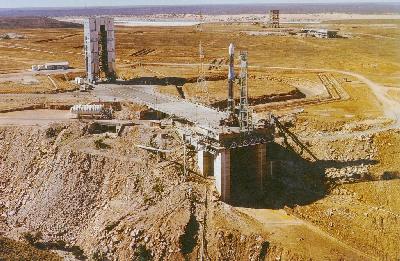
"Three Days at Woomera"
[September 15th-17th, 2001]:
After an extremely enjoyable trip to Florida in 1997 to
witness the Cassini launch I didn't have the money to go Stateside again this year, but I
was determined to include something space-related in my holidays. Where better than
Australia's once-glorious rocket town in the desert? The distance from Melbourne to
Woomera turned out to be roughly 1200 km. After crossing the Murray River via the Waikerie
ferry I spent the second day driving through picturesque rural South Australia, up along
the shores of the Spencer Gulf and arrived at the township at about 5 o'clock on Saturday
afternoon. Just before you reach Bilma and the turnoff to Woomera itself is Island Lagoon,
a large dry lake west of the road from Port Augusta. It was once the site of NASA's Deep
Space Station 41, constructed in 1960. The large dish was 23.5 metres in diameter, used to
communicate with such space probes as Mariner's II, V, VI and VII, not to mention Apollo
11. When the facility was closed in 1972 the antenna was torn down, but the spectacular
view out across enormous Island Lagoon was quite something, my first glimpse of a true
salt lake. Way cool: 
The Once-secret Township
I was concerned that Sunday would be a 'dead' day, with
everything closed as it so often is in the bush. When I checked into the ELDO Hotel I
found out the museum was open 7 days a week, which came as a relief. My building was the
'Redstone' block, room #7: 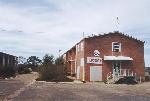
The other blocks bore names like 'Skylark' and 'Black Knight'. Apart from two or three
other people I think I had the place to myself. It felt very empty, though not in the
least run-down. I wandered around for an hour or so before dinner, taking photos of the
historic town marker,
the rocket parks
and the Long Tom
standing on its launcher down by the highway. Taking pride of place amidst the old
missiles and launchers were two cyclone-wire cages full of smashed-up rocket parts, the
first stages of Europa
F4 and the 'Sparta'
Redstone used to launch Wresat, recovered from the desert in the 1990's. The F4 cage
didn't even have a lock on it. I could have filled my car boot with junk and driven off in
the dead of night. On a more serious note, looking at all that twisted debris brought it
home that rockets are a terribly inefficient way of getting itty-bitty little satellites
into orbit: all that scrap metal, once worth a fortune, now not even kept under lock and
key.
Having forgotten to wind my watch back half an hour to
adjust to South Australian time - I WONDERED why I seemed to keep arriving at places too
early! - I arrived at the Heritage Centre just as they were opening for business. I had a
look at the souvenirs and bought a few books and cloth patches. Entrance fee for the
museum proper was a very reasonable $3. The place was chock-full of wonderful old
kinotheodilites and recording equipment, racks of valve electronics, punch-card readers,
hand-cranked telephones and countless other pieces of fascinating 60's-era technology: 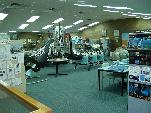
There were plenty of cut-away models of the various rockets and bombs used for tests,
along with an excellent scale model of launch pad 6A, which was the one that hosted all
the Blue Streak and Europa I launches. If I had any complaint it would be that there
weren't any launch photos available. A kit including the Wresat, Black Arrow and Europa
launches would be very welcome. Until my visit I had never seen a color pictre of a Black
Arrow launch other than the famous R3 'Prospero' launch, and the few Europa shots
appearing online are always cropped and of poor quiality. There were some nice Sparta
lift-off pics, and one of Wresat standing on the launch apron that I had never seen
before. I guess my next trip will be to the DSTO at Salisbury to try and get into their
photo archives - assuming they have any, of course.
The Kistler offices are on the main road through town,
right where you can't miss seeing them on the way in: 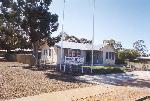
Next-door was a building run by Raytheon, which looked closed every time I went past. On
Monday morning I had a very enjoyable chat with Curtis Johnston, the Director of Launch
Operations for Kistler in Australia. He was upbeat and rarin' to go, and was once in
charge of the early American effort to put spy satellites into orbit atop Atlas-Agena's
from Vandenburg Air Force Base. He said all they needed was a bit more money and
everything would be full steam ahead. He said it was fine for me to go out into the
Restricted Area, so back at the DSCW - Defence Support Centre Woomera - Bruce Henderson
told me the drill and away I went. Once past the airport and through the Tech Area all I
had to do was stop at a boomgate, give my name, car registration and projected visit time
and that was it - no big deal at all, after all my worrying.
The Restricted Area
A sign a kilometre inside the gate reminds you this was
once one of the most highly-guarded places in the Commonwealth. At the height of the Cold
War such things were taken very seriously. I snapped this pic on my way back out: 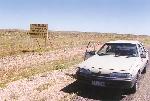
The Kistler site was about 5 minutes' drive west along
the sealed road, on the southern side of a very low hill: 3 white pre-fabs and a diesel
generator: 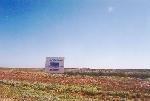
Driving a few hundred metres further along I noticed that the western side of the hill had
some shallow gullies, and Curt later told me that was where the pad/s would go, to
minimise excavation work - which, to my delight, was exactly what I thought upon first
seeing them!
ELDO Launch Complex 6
The road down to the ELDO pads was unsealed and I
managed to miss the turnoff the first time past, even after being told to ,"...keep
an eye out for a pile of rocks with a stick stuck in it." There was no pile of rocks,
not even a sign; just a piece of angle-iron jammed into the ground. Once upon a time it
would have been a much-travelled stretch of road, millions of pounds' worth of hardware
arriving weekly. Ah, only in Australia...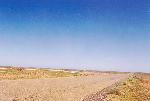
There had been quite a bit of rain in the week before I
arrived, and lots of desert plants were blooming. Lake Hart had a large pool of water away
to the south. Surrounded by white salt it looked like distant, frozen surf, definately
worth the drive on its own.
Such is the scarcity of good information about Launch Complex 6 that I wasn't even sure
which pad was 'A' and which was 'B'. Only by comparing my pics with those in books such as
"Fire Across the Desert" was I able to convince myself later. As it was, I
turned left and ended up at launcher 'B' first, Lake Hart shimmering in the distance: 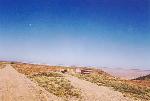
It is still a mighty impressive piece of concrete, looming over a steep-sided valley that
drops 30 or 40 metres down to the dry creek bed below.
I walked out to the headland and took this shot, looking back: 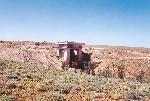
I was surprised to find no trace of grafitti, even though the side facing the rails was
pocked with bullet holes: 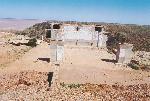
Launcher 'A' is practically identical. Only the slab of
concrete beside it standing on four posts identifies it to the casual observor: 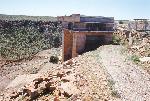
Its status as the sole operational pad is evidenced by the numerous concrete observation
positions surrounding it, their windows all aimed strait at the apron where the vehicle
once stood: 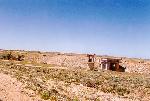
Other than that, only a few drainage channels and small concrete structures indicate that
it was fully finished, as opposed to 'B' which missed out on some of the fiddly extras.
It's a pity the 'bridges' linking the pads to the hilltops were removed long ago. Climbing
up onto them now would take determination and some rockclimbing experience. Perhaps they
don't want people falling off them! It was nice being trusted to be out there on my
own, perhaps the only person for 20 kilometres in any direction.
I only just managed to remember to take a self-portrait in front of it: 
All in all, the visit was highly worth it, and I would have been very disappointed not to make it out to the pads. Tours are run twice a week, as long as six people sign on beforehand. I suppose in that regard I might consider myself lucky, but knowing what you're talking about helps a LOT. It was a sobering thought to consider that at one time they represented the pinnacle of an expensive, hi-tech enterprise matched only by the Soviet Union and the USA. Australia was right up there with the big boys, all right. Only Government apathy and fiscal tight-fistedness prevented us from maintaining that lead. Who knows where we might have been today if the money hadn't run out. I plan on going back once operational launches commence, whoever manages to be the first to succeed, although NEXT time I'll fly there! I can only hope Kistler, Spacelift and United Launch Services have more luck dealing with the Government than other proposals have in the past, because let's face it, if the Government isn't interested you might as well give up and go overseas.
The major Woomera launches, in order:
Vehicle Flight Satellte Date
Blue Streak
F1
5th June, 1964
Blue Streak
F2
20th October, 1964
Blue Streak
F3
22nd March, 1965
Europa I
F4
24th May, 1966
Europa I
F5
13th November, 1966
Black Arrow
R0
28th June, 1967
Europa I
F6/1
4th August, 1967
Europa I
F6/2
5th December, 1967
Redstone 'Sparta'
Wresat 29th November, 1967
Europa I
F7
30th November, 1968
Europa I
F8
3rd July, 1969
Black Arrow
R1
4th March, 1970
Europa I
F9
12th June, 1970
Black Arrow
R2
2nd September, 1970
Black Arrow R3
Prospero
28th October, 1971